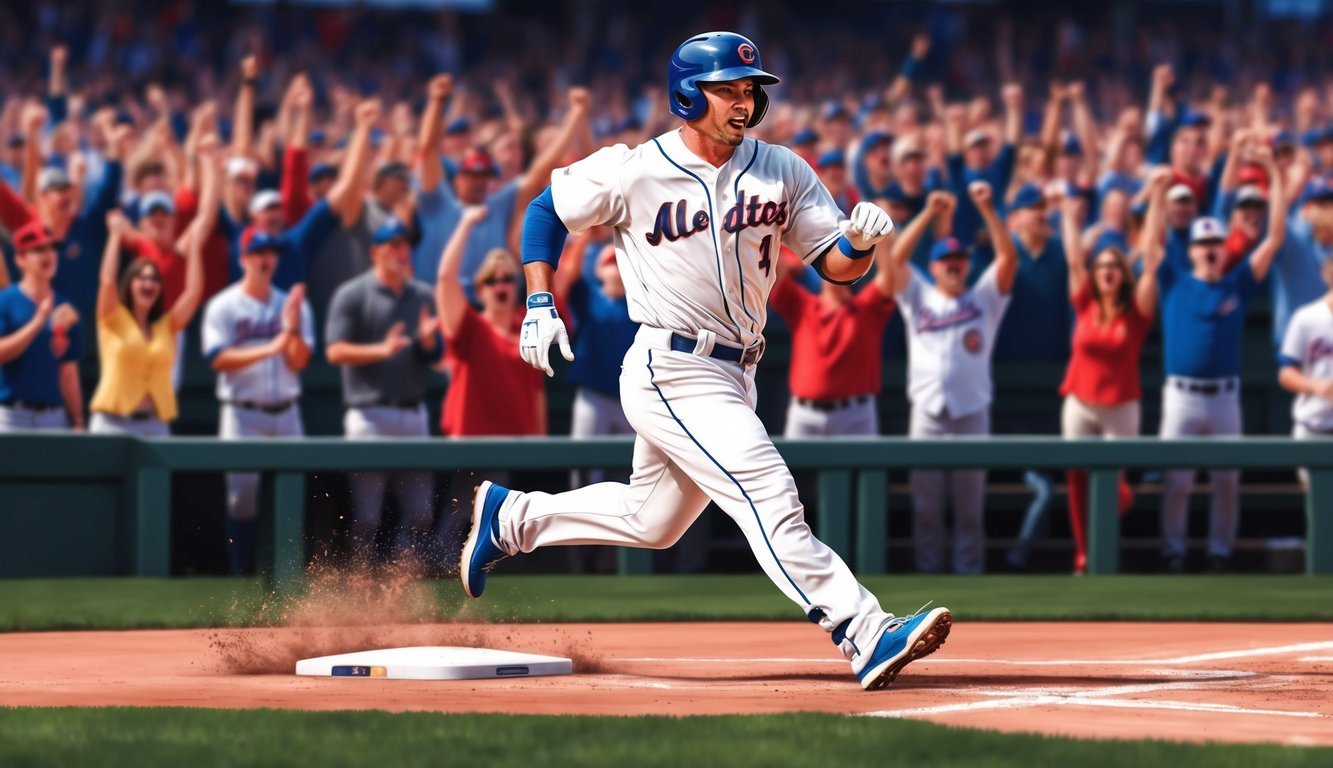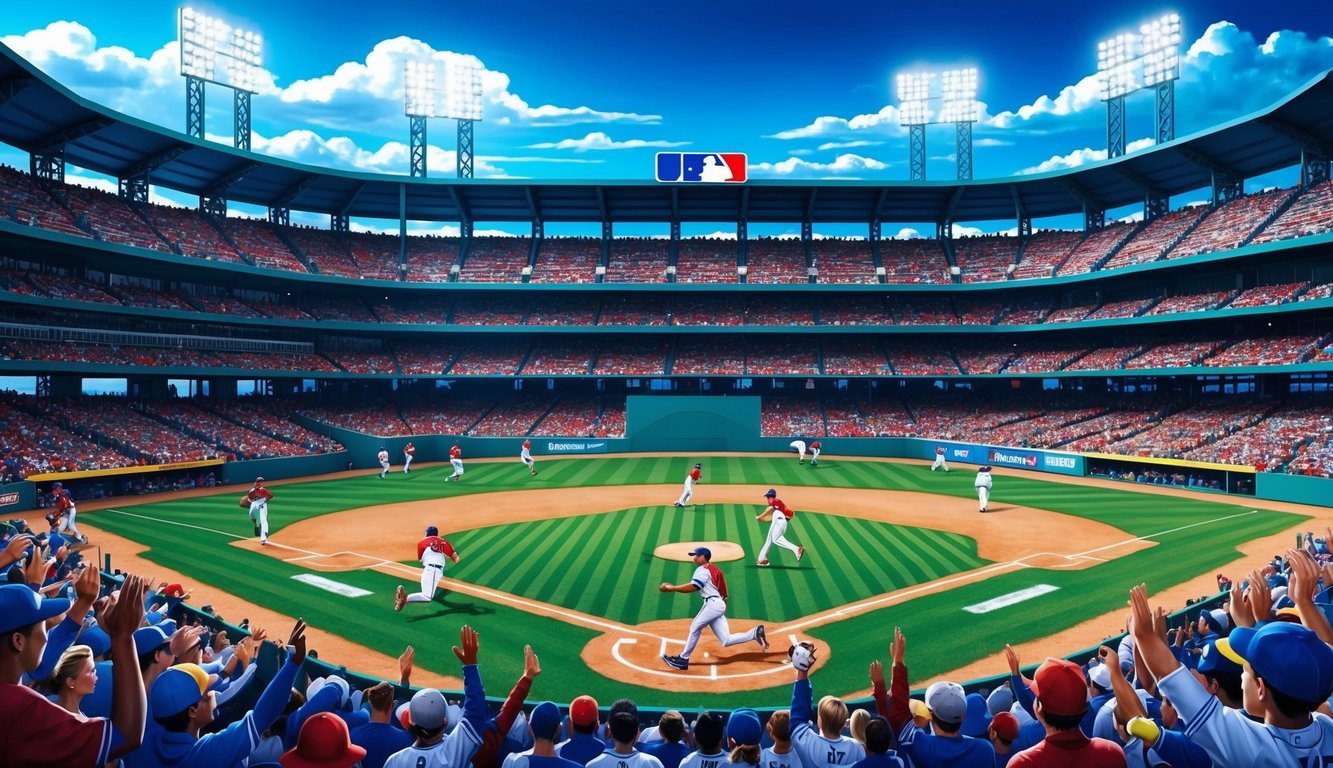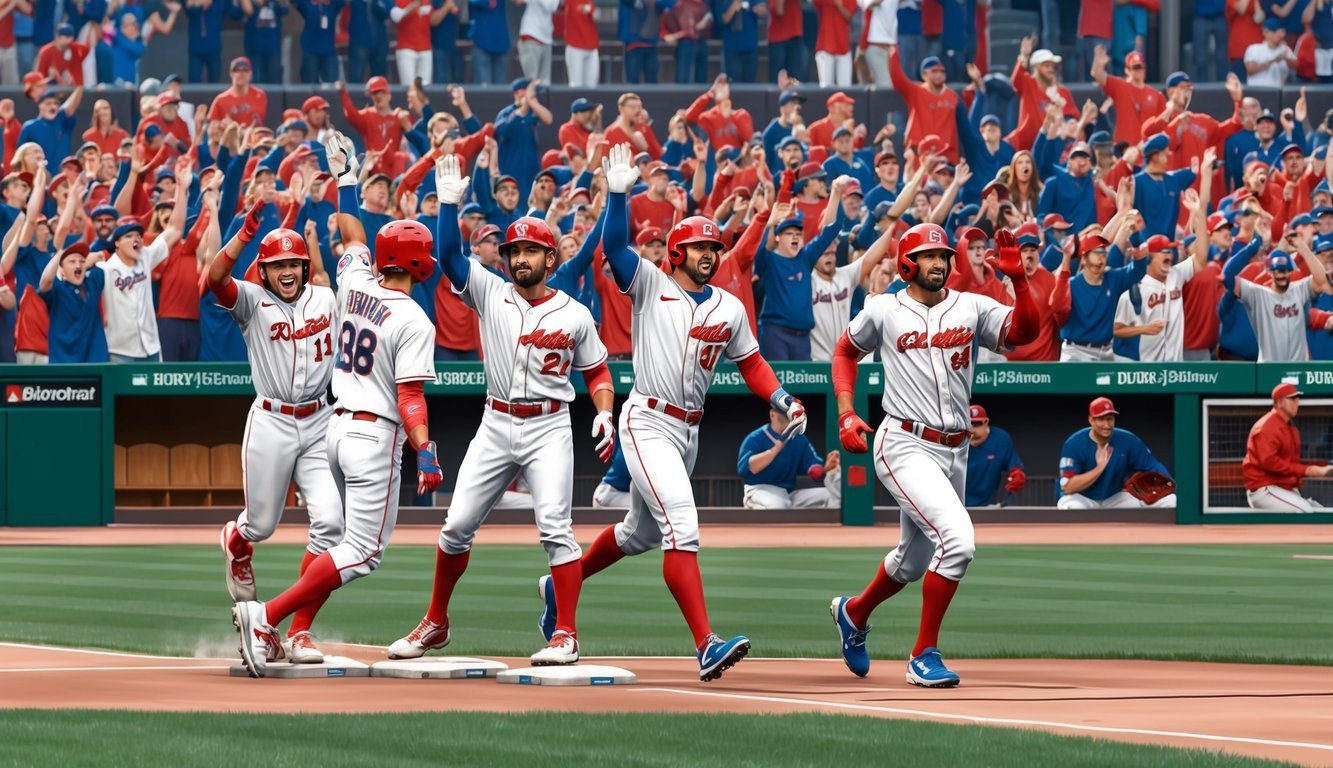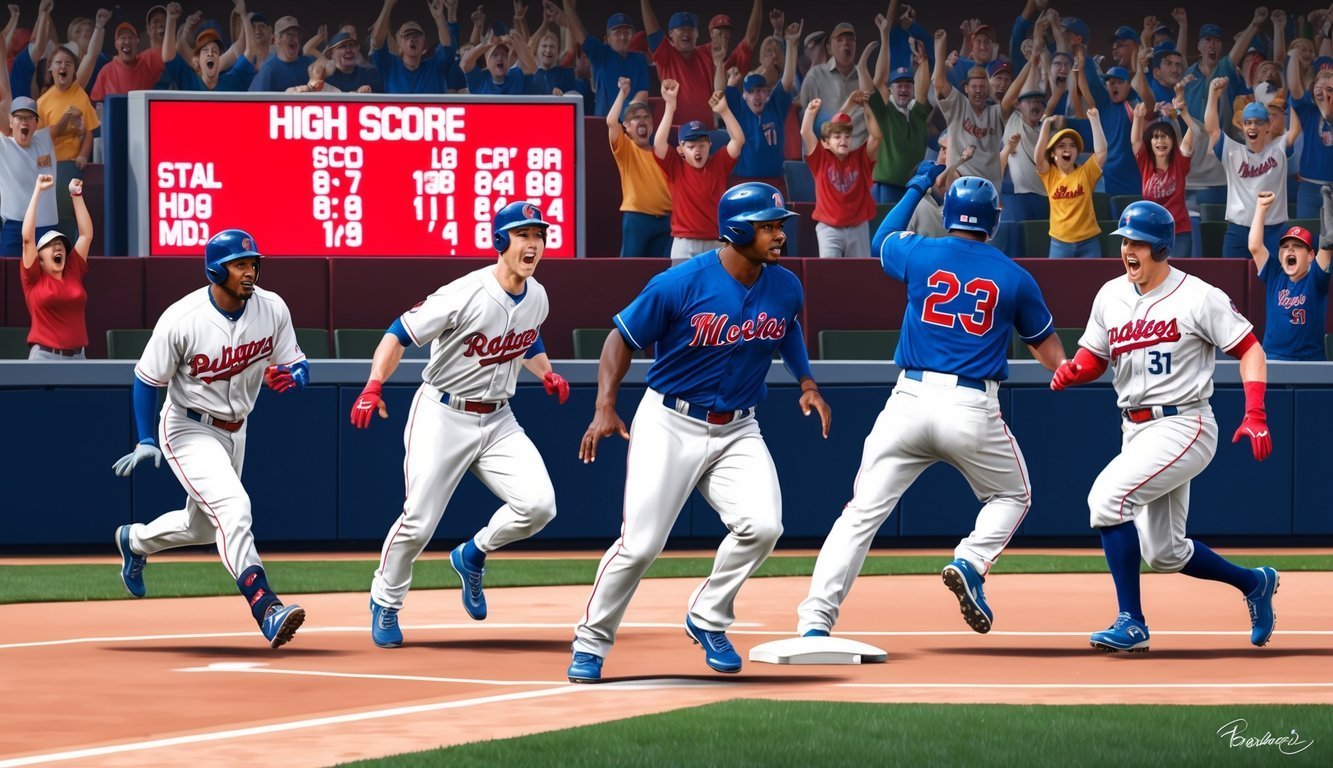Baseball fans love a high-scoring game, and few matchups deliver excitement quite like those that break records for runs scored.
In Major League Baseball history, offensive explosions have led to some truly remarkable totals on the scoreboard.
The Chicago Colts achieved the highest number of runs scored by a single team in an MLB game.
They scored 36 runs against the Louisville Colonels on June 29, 1897. While this record has stood for over a century, modern teams have come close to matching it.
In recent years, the Toronto Blue Jays put up an impressive 28 runs against the Boston Red Sox on July 22, 2022, tying the American League record.
These slugfests showcase the raw power and skill of MLB hitters when they’re firing on all cylinders.
From multiple home runs to bases-clearing doubles, such games often feature individual hitting performances that live on in baseball lore.
While pitchers may prefer to forget these outings, fans and statisticians alike relish the chance to witness history being made one run at a time.
Historical Highlights
Major League Baseball has seen some incredible offensive displays over the years.
From record-breaking team performances to individual heroics, the sport’s history is filled with high-scoring affairs that have left fans in awe.
Many of these thrilling moments have become legendary, showcasing the talent and power of athletes as they push the boundaries of what is possible on the field.
However, the sport’s history is not without its controversies, such as the infamous Black Sox scandal overview, which serves as a stark reminder of the darker side of baseball.
Despite these incidents, the allure of explosive offensive performances continues to captivate fans and shape the narrative of America’s pastime.
Notable Games
The highest-scoring game in MLB history took place on August 25, 1922.
The Chicago Cubs defeated the Philadelphia Phillies 26-23 in a wild shootout at Cubs Park.
The game featured 49 total runs, 51 hits, and 23 walks.
Another memorable slugfest occurred on June 29, 1897, when the Chicago Colts (now Cubs) scored an astounding 36 runs against the Louisville Colonels.
This remains the record for most runs scored by a single team in an MLB game.
More recently, the Texas Rangers set the modern-era record for runs in a game when they crushed the Baltimore Orioles 30-3 on August 22, 2007.
Record-Breaking Teams
The 1930 Philadelphia Phillies hold the record for most runs scored in a season with 1,199.
Despite this offensive prowess, they finished last in the National League with a 52-102 record.
The 1931 New York Yankees set the American League record by scoring 1,067 runs.
This star-studded lineup featured Hall of Famers Babe Ruth and Lou Gehrig.
In 2000, the Colorado Rockies became the first team in the modern era to score 1,000 runs in a season, finishing with 1,009.
The high-altitude Coors Field played a significant role in this accomplishment.
Famous Players’ Contributions
Shawn Green had the most productive offensive game in MLB history on May 23, 2002.
Playing for the Los Angeles Dodgers, Green went 6-for-6 with four home runs, a double, and a single.
His 19 total bases remain an MLB record.
On July 10, 1932, Cleveland Indians outfielder Johnny Hodapp set the record for most hits in a nine-inning game, going 7-for-7 against the Chicago White Sox.
In 1936, Yankees legend Lou Gehrig drove in a record 184 runs, a testament to his incredible consistency and power.
This mark still stands as the American League record for RBIs in a season.
Statistical Analysis
Major League Baseball has seen some remarkable offensive performances throughout its history.
Teams have occasionally achieved extraordinary run totals, shattering records and leaving fans in awe.
Scoring by Decade
In the early 1900s, high-scoring games were more common due to different playing conditions and equipment.
The 1920s and 1930s saw a surge in offensive output, with several teams scoring over 20 runs in a single game.
The 1950s and 1960s experienced a dip in scoring, as pitching dominated.
However, the late 1990s and early 2000s witnessed another offensive explosion.
The Texas Rangers set the modern record in 2007, scoring 30 runs against the Baltimore Orioles.
Recent years have shown a slight decrease in extreme scoring games, but teams still occasionally reach the 20-run mark.
Home Runs & Offensive Stats
Home runs play a significant role in high-scoring games.
In the Rangers’ 30-run game, they hit six homers.
The Atlanta Braves’ 29-run outburst in 2020 included seven long balls.
Other offensive stats in these games are equally impressive.
Teams often rack up 20+ hits, with multiple players recording 4+ hits.
RBI totals for individual players can reach double digits.
Interestingly, high-scoring games don’t always correlate with league-wide offensive trends.
They can occur in any era, showcasing baseball’s unpredictable nature.
Impactful Players

Baseball’s greatest run-scorers have left an indelible mark on the sport.
These players consistently crossed home plate, shaping game outcomes and setting records that stand the test of time.
Career Run Leaders
Rickey Henderson tops the all-time runs scored list with an astounding 2,295 runs.
Known for his blazing speed and keen eye at the plate, Henderson terrorized pitchers for over two decades.
Ty Cobb follows closely with 2,245 runs, showcasing his legendary batting skills and aggressive baserunning.
Babe Ruth, the Sultan of Swat, rounds out the top three with 2,174 runs.
His power-hitting revolutionized the game, often scoring himself with towering home runs.
Other notable career run leaders include Hank Aaron (2,174), Pete Rose (2,165), and Willie Mays (2,062).
These players’ ability to get on base and score consistently made them invaluable to their teams.
Single-Game Record Holders
On July 7, 1923, the Cleveland Indians set the MLB record for most runs scored in a single game, crossing home plate 27 times against the Boston Red Sox.
Rube Lutzke and Riggs Stephenson were key contributors, driving in a combined 11 runs.
Individual single-game run records are equally impressive.
In modern baseball, players like Pete Crow-Armstrong, Michael Toglia, and James Wood have each scored 4 runs in a game during the 2024 season.
Historic performances include Guy Hecker’s 7 runs in a single game in 1886, setting a record that still stands.
More recently, players like Shawn Green have approached this mark, scoring 6 runs in a game in 2002.
Iconic Ballparks

Certain stadiums have become legendary in baseball history, not just for their architecture but for the memorable games and high-scoring affairs they’ve hosted.
These parks have seen their fair share of offensive explosions and historic moments.
Fenway Park’s History
Fenway Park, home of the Boston Red Sox since 1912, is a treasure trove of baseball lore.
Its quirky dimensions, including the famous Green Monster in left field, have influenced countless games.
The Red Sox have enjoyed some tremendous offensive outputs here, like their 29-4 victory over the St. Louis Browns in 1950.
Fenway has also seen visiting teams rack up impressive run totals.
In 2019, the New York Yankees scored 19 runs against the Red Sox in a single game at Fenway.
Other Historic Venues
Coors Field in Denver, home of the Colorado Rockies, is known for its high-scoring games due to the thin air at altitude.
The Rockies’ highest-scoring game at Coors was a 20-1 win over the San Francisco Giants in 1995.
Wrigley Field in Chicago has hosted its share of slugfests too, including a wild 23-22 Cubs victory over the Phillies in 1979.
These parks, along with others like Yankee Stadium and Dodger Stadium, have been the stage for some of MLB’s most memorable offensive displays.
Understanding the Game

Baseball’s high-scoring games result from a blend of strategy, skill, and sometimes a bit of luck.
Teams employ various tactics to rack up runs while pitchers and defenders work to prevent them.
The Role of Strategy
Managers play a crucial part in high-scoring games.
They decide when to be aggressive on the basepaths, steal bases, or attempt hit-and-runs.
Lineup construction is key, with power hitters strategically placed to maximize run production.
Teams might adjust their approach based on the opposing pitcher’s strengths and weaknesses.
For instance, they may focus on working the count against a control pitcher or swing early against a flamethrower.
In blowout games, managers often use relief pitchers to save their best arms for closer contests.
This can lead to even more runs as less experienced pitchers face major league hitters.
Rules and Regulations
MLB rules shape the potential for high-scoring games.
The designated hitter rule in the American League often leads to more offense compared to the National League, where pitchers typically bat.
Ballpark dimensions also play a role.
Smaller parks like Fenway Park or Yankee Stadium can turn routine fly balls into home runs.
The thin air in Colorado’s Coors Field famously boosts offense.
Grand slams, worth four runs, can quickly inflate scores.
There’s no mercy rule in MLB, so games can theoretically continue indefinitely, allowing for extreme scorelines.
Umpires ensure fair play, but their strike zone interpretation can influence scoring.
A tighter zone may lead to more walks and scoring opportunities, while a larger zone can favor pitchers.
